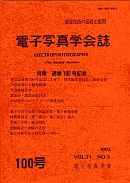Volume 30, Issue 1
Displaying 1-12 of 12 articles from this issue
- |<
- <
- 1
- >
- >|
-
1991Volume 30Issue 1 Pages 2-15
Published: 1991
Released on J-STAGE: June 06, 2007
Download PDF (1721K) -
1991Volume 30Issue 1 Pages 16-21
Published: 1991
Released on J-STAGE: June 06, 2007
Download PDF (680K) -
One Drum Color Superimposing Process: Electrostatic Effect of the Toner Layer on the Image Formation1991Volume 30Issue 1 Pages 22-29
Published: 1991
Released on J-STAGE: June 06, 2007
Download PDF (2221K) -
1991Volume 30Issue 1 Pages 30-35
Published: 1991
Released on J-STAGE: June 06, 2007
Download PDF (1186K) -
1991Volume 30Issue 1 Pages 36-43
Published: 1991
Released on J-STAGE: June 06, 2007
Download PDF (866K) -
1991Volume 30Issue 1 Pages 44-48
Published: 1991
Released on J-STAGE: June 06, 2007
Download PDF (491K) -
1991Volume 30Issue 1 Pages 52-60
Published: 1991
Released on J-STAGE: June 06, 2007
Download PDF (1629K) -
1991Volume 30Issue 1 Pages 61-65
Published: 1991
Released on J-STAGE: June 06, 2007
Download PDF (804K) -
1991Volume 30Issue 1 Pages 66-72
Published: 1991
Released on J-STAGE: June 06, 2007
Download PDF (3735K) -
1991Volume 30Issue 1 Pages 73-81
Published: 1991
Released on J-STAGE: June 06, 2007
Download PDF (1858K) -
1991Volume 30Issue 1 Pages 82-85
Published: 1991
Released on J-STAGE: June 06, 2007
Download PDF (435K) -
1991Volume 30Issue 1 Pages 86-90
Published: 1991
Released on J-STAGE: June 06, 2007
Download PDF (2523K)
- |<
- <
- 1
- >
- >|
